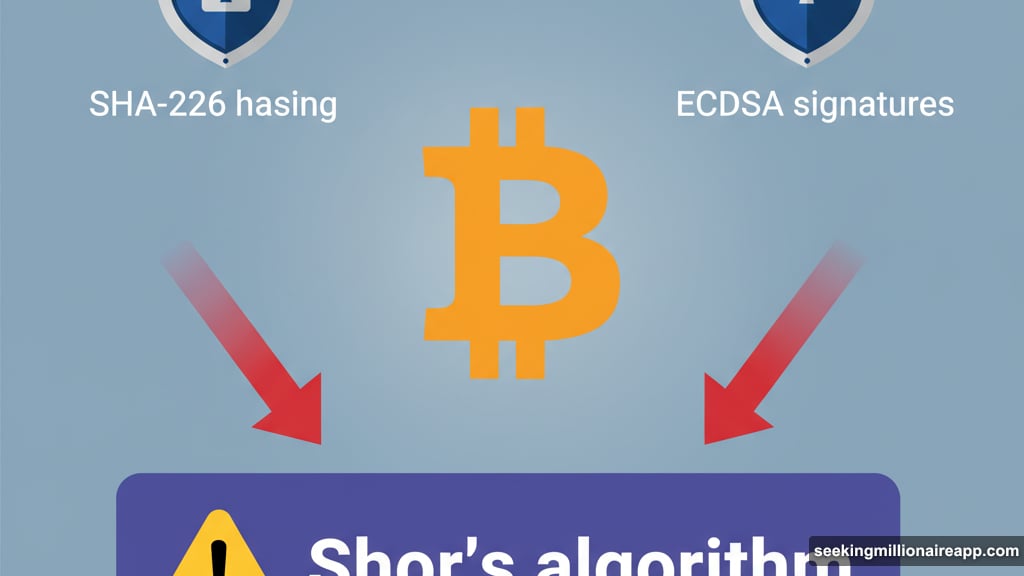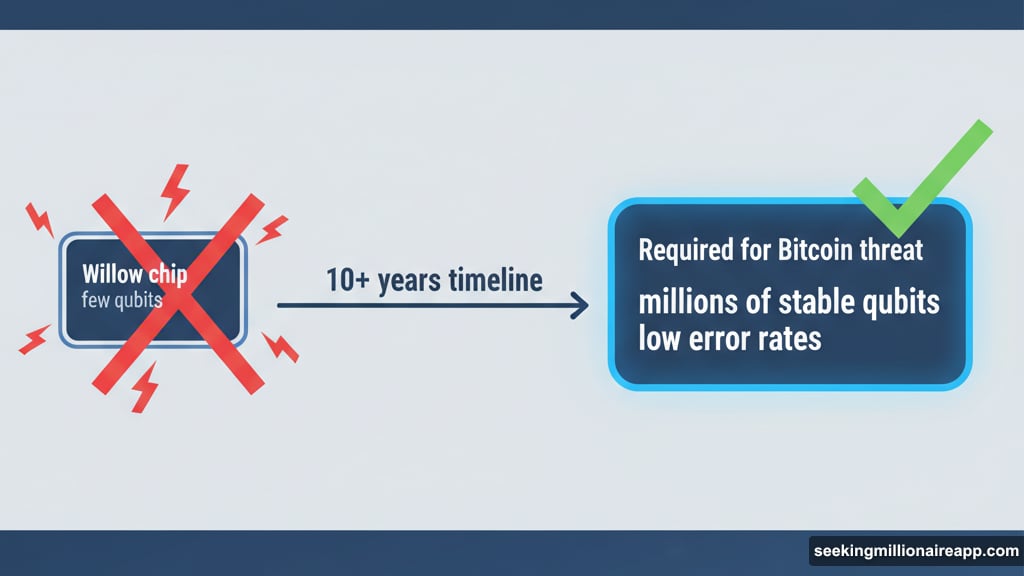Google just claimed a major quantum computing breakthrough. Naturally, the crypto world panicked.
The tech giant says its Willow chip solved a problem that would take traditional supercomputers thousands of years. So Bitcoin holders immediately asked the obvious question: Can quantum computers crack crypto wallets?
Short answer? Not yet. But the concern isn’t completely baseless.
What Google Actually Built
Willow completed a specific calculation in two hours. That same task would supposedly take classical supercomputers far longer than the age of the universe.
Sounds terrifying. But here’s the context most headlines skip.
The chip simulated quantum chaos using Out-of-Time-Order Correlators. That’s a benchmark for tracking unpredictable particle behavior. Impressive for physics research. Less immediately relevant for breaking encryption.
Moreover, this achievement measures quantum advantage in controlled laboratory conditions. Real-world applications remain distant. Plus, the specific calculations Willow performed don’t directly translate to cracking cryptographic keys.
Still, the milestone represents genuine progress. Quantum computing moved closer to practical applications like molecular modeling. That’s meaningful scientific advancement, even if it doesn’t immediately threaten Bitcoin.
Why Crypto Folks Are Nervous
Bitcoin’s security relies on cryptographic methods. Quantum computers could theoretically break these protections.
Currently, Bitcoin uses SHA-256 hashing and ECDSA signatures. Traditional computers would need millions of years to crack these systems through brute force. But quantum computers work differently.
They leverage quantum mechanics to solve certain problems exponentially faster. Specifically, Shor’s algorithm could theoretically factor large numbers efficiently. That matters because Bitcoin’s security depends on the difficulty of such calculations.
So the fear makes sense. If quantum computers mature enough, they could potentially derive private keys from public addresses. That would compromise wallet security fundamentally.

However, several crucial factors separate today’s reality from that scenario.
The Reality Check Nobody Mentions
Experts keep saying the same thing. We’re nowhere near quantum computers cracking Bitcoin.
“There’s no evidence today that any computer, even a classified one, can break modern cryptography,” said Kostas Kryptos Chalkias, chief cryptographer at Mysten Labs. “We’re at least 10 years away from that.”
Ten years represents the optimistic timeline. Many researchers suggest longer.
Why the gap? Building a quantum computer powerful enough requires millions of stable qubits. Willow reportedly uses far fewer. Plus, those qubits must maintain coherence long enough to complete complex calculations.
Currently, quantum computers struggle with error rates. They make mistakes constantly. Researchers spend enormous effort just keeping calculations accurate for minutes.
Breaking Bitcoin’s cryptography would require sustained, error-free computation over extended periods. That capability remains theoretical. Furthermore, the quantum computer would need sufficient qubits specifically configured for cryptographic attacks.
Three Reasons Bitcoin Isn’t Doomed
First, the crypto community isn’t sitting idle. Developers actively research quantum-resistant cryptography.
Several proposals exist for upgrading Bitcoin’s protocols. These include lattice-based cryptography and hash-based signatures. Both approaches resist known quantum algorithms.
Implementing these changes takes time. But Bitcoin has successfully upgraded before. The network could adopt quantum-resistant measures once the threat becomes concrete.
Second, quantum computers won’t appear overnight. The technology advances incrementally.

That gives the crypto ecosystem years to respond. We’ll see quantum capabilities improving gradually. So Bitcoin can evolve its defenses proportionally.
Think of it like an arms race with visible progress on both sides. Nobody gets surprised by sudden breakthroughs that immediately compromise everything.
Third, quantum computing faces physical constraints. Building powerful quantum computers requires extreme conditions.
What Actually Moved Markets
Google’s announcement barely budged Bitcoin prices. BTC climbed briefly to $109,000, then fell back to around $108,150.
That 0.7% movement disappeared within hours. Hardly panic selling.
Meanwhile, Alphabet stock (Google’s parent company) jumped 1.5% before settling back. So investors viewed this primarily as good news for Google’s research capabilities. Not as an immediate threat to crypto.
The market’s calm response suggests most participants understand the timeline. Quantum computing represents a distant concern, not an urgent crisis.
However, this topic will resurface repeatedly. Every quantum computing announcement triggers the same debate. Expect continued volatility around these news cycles.
The Real Timeline
Most experts place practical quantum threats at least a decade away. Some suggest 20-30 years.
That timeline assumes continued rapid progress. But quantum computing development has slowed before. Technical hurdles constantly emerge.
For example, maintaining qubit coherence gets exponentially harder as systems scale. Adding more qubits introduces more potential error sources. Solving these problems requires fundamental breakthroughs, not just incremental improvements.

So predictions remain uncertain. We might see faster progress than expected. Or development could plateau for years.
The key point? Bitcoin has time to adapt. The network won’t suddenly become vulnerable overnight.
What Bitcoin Holders Should Actually Do
Stop panicking about quantum computing. Seriously.
Your Bitcoin remains secure for the foreseeable future. Focus on immediate security concerns instead. Use hardware wallets. Enable two-factor authentication. Practice good operational security.
Those practical measures matter far more than hypothetical quantum threats. Most crypto gets stolen through phishing, weak passwords, or exchange hacks. Quantum computers rank nowhere near the top of actual risk factors.
That said, stay informed. Follow developments in quantum-resistant cryptography. Support projects researching post-quantum security.
But don’t lose sleep over Google’s latest chip. The crypto community has years to respond.
Nobody’s Hacking Bitcoin Tomorrow
Quantum computing will eventually challenge current cryptography. That’s inevitable.
But “eventually” means decades, not months. Plus, Bitcoin can upgrade its security protocols long before quantum computers pose genuine threats.
The real story here isn’t about Bitcoin’s doom. It’s about Google achieving meaningful scientific progress. Those are separate narratives that keep getting conflated.
So appreciate the quantum computing breakthrough for what it represents. Just don’t panic about your crypto holdings. The timeline gives everyone involved plenty of warning.
Stay alert. Stay informed. But stay calm.
